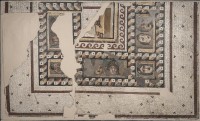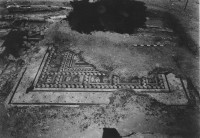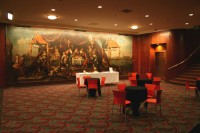 The Wadsworth Atheneum Museum of Art in Hartford, Connecticut, reopened in September of 2015 after a five-year renovation that fixed structural issues, redesigned all the galleries and storage facilities, updated the climate control systems and technology. The refurbished museum was a huge hit with critics and visitors alike, but people who visited before last October of who stuck to the exhibition galleries have missed a long-lost gem: a 3rd century mosaic floor from Antioch in the Loctite Lobby of the Aetna Theater that was hidden for decades under atrocious convention hall carpeting.
The Wadsworth Atheneum Museum of Art in Hartford, Connecticut, reopened in September of 2015 after a five-year renovation that fixed structural issues, redesigned all the galleries and storage facilities, updated the climate control systems and technology. The refurbished museum was a huge hit with critics and visitors alike, but people who visited before last October of who stuck to the exhibition galleries have missed a long-lost gem: a 3rd century mosaic floor from Antioch in the Loctite Lobby of the Aetna Theater that was hidden for decades under atrocious convention hall carpeting.
The 13-by-10 foot mosaic is composed of limestone and multicolored glass tiles. A white border with small black stepped diamonds surrounds panels of theatrical masks, male and female, comic and tragic, young and old. Deep cuboids in perspective outline the mask panels. What was once the central panel is now almost entirely gone. Only the bottom left corner depicting a pair of sandaled feet on a footstool survives.
 It was discovered in Room 2 of a private dwelling known as the House of the Mysteries of Isis because two of the mosaics in the house show scenes from Isian ritual. It was excavated in the 1930s by an archaeological team led by Princeton University which excavated ancient Antioch (modern-day Antakya, Turkey) from 1932 through 1939. As per the partage system which was customary at the time, the spoils of archaeological digs were divided among interested parties — involved institutions, financial supporters, local government. More than 300 mosaics and untold numbers of artifacts were unearthed during the seven years of Antioch excavations. Princeton’s share is now in the University Art Museum.
It was discovered in Room 2 of a private dwelling known as the House of the Mysteries of Isis because two of the mosaics in the house show scenes from Isian ritual. It was excavated in the 1930s by an archaeological team led by Princeton University which excavated ancient Antioch (modern-day Antakya, Turkey) from 1932 through 1939. As per the partage system which was customary at the time, the spoils of archaeological digs were divided among interested parties — involved institutions, financial supporters, local government. More than 300 mosaics and untold numbers of artifacts were unearthed during the seven years of Antioch excavations. Princeton’s share is now in the University Art Museum.
 The Wadsworth was not one of the interested parties. The mosaic was purchased for $300 in 1940 by Atheneum director Chick Austin and was installed in the theater lobby. It had been raised in two sections back in the 1930s. When they were embedded in the terrazzo floor, the sections were put back together in a configuration that minimized gaps but paid no heed to the original logic and composition of the piece. Then, for reasons unknown and unfathomable today, the whole floor was covered in hideous wall-to-wall carpeting in the 1960s or 70s. Granted, those were dark days for interior decorating, but this seems extreme even for the era of avocado appliances.
The Wadsworth was not one of the interested parties. The mosaic was purchased for $300 in 1940 by Atheneum director Chick Austin and was installed in the theater lobby. It had been raised in two sections back in the 1930s. When they were embedded in the terrazzo floor, the sections were put back together in a configuration that minimized gaps but paid no heed to the original logic and composition of the piece. Then, for reasons unknown and unfathomable today, the whole floor was covered in hideous wall-to-wall carpeting in the 1960s or 70s. Granted, those were dark days for interior decorating, but this seems extreme even for the era of avocado appliances.
“People knew it was there, but as the years went by it was less on everybody’s radar,” conservator Alan Kosanovich said.
Last October, the carpeting was pulled up “to give the lobby a fresher look,” he said. The mosaic and the terrazzo floor surrounding it were revealed. After Kosanovich cleaned and toned the piece, a railing was installed around it. Now, Atheneum visitors can see it, but not walk on it. […]
The mosaic can be seen by all museum visitors, although those not going to a film screening or a live performance might not think to go to the basement theater to see it. It’s worth a trek down the stairs, to see an intriguing piece of ancient history, which sat ignored for decades under a common carpet.
Getting covered by hideous 1970s motel carpet isn’t the worst treatment received by an Antioch mosaic. In 1951 Princeton installed a small rectangular mosaic, once the border of a larger piece, raised during the university’s Antioch excavations in the vestibule of the Architecture Laboratory. Out in the open where an endless parade of students and faculty tramped on it daily and it was at the mercy of the vagaries of New Jersey weather for decades. You’d think an ancient mosaic literally at the threshold of an architecture lab would be handled with some basic level of competence, but you would be wrong. Every time some of the tesserae got loose, they just slapped a layer of cement on top.
Sixty years after it was installed, the mosaic finally got some attention. Conservators removed it in July 2011 and transported it to the Art Conservation Group’s Brooklyn studio for cleaning, consolidation and restoration. It was reinstalled, indoors this time, at the School of Architecture on March 19th, 2013. The removal and reinstallation was filmed, and it’s an interesting look not just as modern conservation methods, but also at how these mosaics were raised in the first place.
[youtube=https://youtu.be/Dlg8-TqLEPQ&w=430]